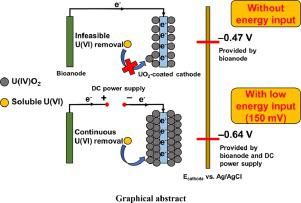Resources, Conservation and Recycling ( IF 13.2 ) Pub Date : 2021-10-21 , DOI: 10.1016/j.resconrec.2021.105993 Wenbin Liu 1, 2 , Leiming Lin 1, 2 , Yukang Qie 1, 2 , Ying Meng 1 , Fubo Luan 1, 2

|
Microbial fuel cell (MFC) is a feasible technology for uranium removal and recovery from uranium-containing wastewater. However, the accumulation of reductive product (UO2) on the cathode surface hindered the continuous removal of uranium due to the increase of over-potential. In this study, we developed a microbial electrolysis cell (MEC) system in a mixed microbial consortium with a low energy input that can continuously remove uranium on the UO2-coated cathode. Thermodynamic calculation results demonstrated that the cathode potential controls U(VI) removal in the MEC system, and U(VI) removal was the contribution of the microbial process and the applied voltage (Eap). Experimental results indicated that the cathode potential for the electrochemical reduction of U(VI) on the UO2-coated cathode was about –0.64 V vs. Ag/AgCl, whereas the microbial species in the anode of MEC can provide an Ecathode of –0.47 V vs. Ag/AgCl. Therefore, only a small Eap (about 150 mV) can trigger the continuous U(VI) removal in the MEC. The continuous removal capacity of the UO2-coated cathode was evaluated over 15,830.86 μmol m−2, and the removal efficiencies were higher than 94.0% after all the 22 cyclic tests. Furthermore, over 98.0% of uranium can be recovered from the cathode by acid or alkali method, and the recovery process does not affect the electrode itself. The excellent continuous removal capacity and reusability of the electrode demonstrate that MEC is a promising technology for U(VI) removal from wastewater.
中文翻译:

生物电化学系统中连续高效的铀回收
微生物燃料电池(MFC)是一种可行的从含铀废水中去除和回收铀的技术。然而,由于过电位的增加,阴极表面还原产物(UO 2)的积累阻碍了铀的连续去除。在这项研究中,我们在混合微生物聚生体中开发了一种微生物电解池 (MEC) 系统,该系统具有低能量输入,可以连续去除 UO 2涂层阴极上的铀。热力学计算结果表明,阴极电位控制 MEC 系统中 U(VI) 的去除,U(VI) 去除是微生物过程和外加电压 (E ap)。实验结果表明,对于在UO电化学还原U(Ⅵ)的阴极电位2涂覆的阴极为约-0.64 V,相对于银/氯化银,而在MEC的阳极中的微生物物种能够提供一个E阴极的- 0.47 V vs. Ag/AgCl。因此,只有很小的 E ap(约 150 mV)才能触发 MEC 中的连续 U(VI) 去除。在 15,830.86 μmol m -2 范围内评估了UO 2涂层阴极 的连续去除能力,经过22次循环试验,去除率均高于94.0%。此外,通过酸法或碱法可以从阴极回收98.0%以上的铀,回收过程不影响电极本身。电极优异的连续去除能力和可重复使用性表明 MEC 是一种很有前景的去除废水中 U(VI) 的技术。


























 京公网安备 11010802027423号
京公网安备 11010802027423号